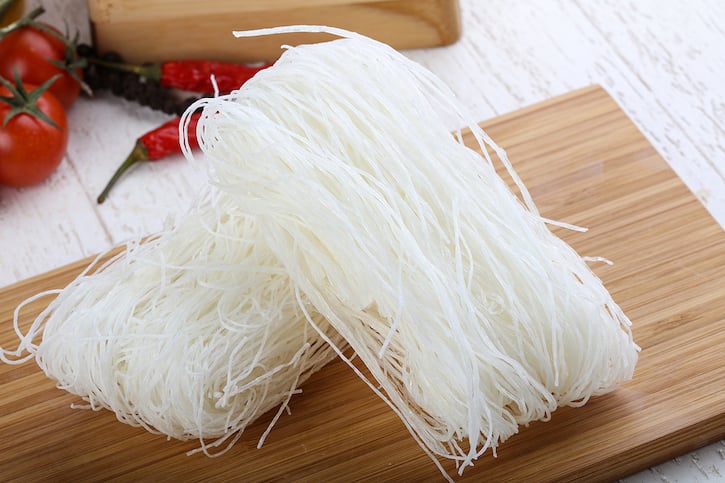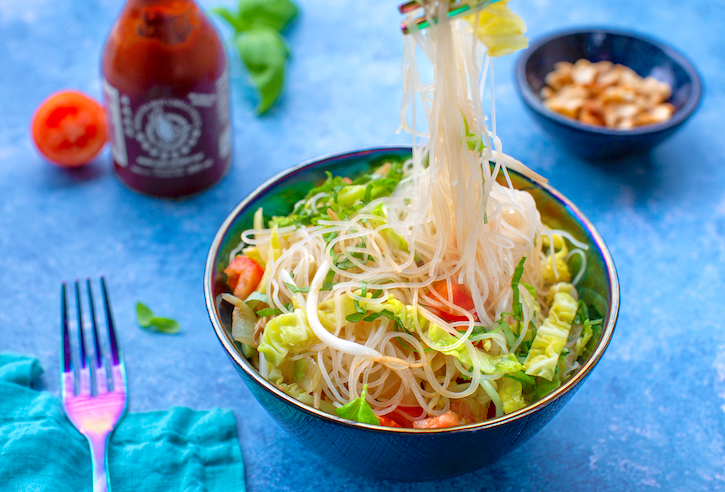how to cook bean thread noodles
Here's a quick guide to bean-thread noodles, also known as cellophane or glass noodles, among other names — with how to buy and prepare them, with links to recipes. This is a noodle with many names. In addition to the above, you may find them marketed and served as mung bean noodles (or mung bean vermicelli), glass noodles, saifun, or harusame.

However they're labeled, these fine, transparent cellophane noodles are made of a plant-based starch — traditionally mung bean starch. Other types of starches might be used as well, including potato starch and tapioca.
For simplicity's sake, we'll refer to them as bean-thread noodles here. Silky and almost gelatinous in texture, they're commonly used in Japan and China we encounter in the west. They're a staple in many other Southeast Asian cuisines, including, Thai, Indonesian, and Vietnamese, and the Philippines. For the curious, you'll find more details about bean-threads here.
Bean-thread noodles and rice noodles are often confused for one another. Bean-threads are NOT fine rice noodles. They're often sold in the same area, especially if supermarkets carry them both. They're both pale in color, very thin, and and can almost be used interchangeably. There's a difference in texture — bean threads, as mentioned, are silky; rice noodles are starchier and if overcooked can even be a bit sticky.
Are bean-thread noodles good for you?
Bean-thread noodles are gluten-free. If you're super-sensitive, you need to make sure they weren't packaged in a facility that uses wheat.
Let's not pretend that bean-threads are a nutritional powerhouse! They're used in small quantities to give visual and textural interest to dishes. They're lower in fat and calories than ordinary pasta, but they also don't provide any fiber or protein to speak of. They provide an array of B vitamins and some minerals. You can learn more about their nutritional content here.

How to buy and cook bean-thread noodles
Bean-threads are available in natural-food stores and Asian groceries, and increasingly in the International foods aisle in supermarkets. These noodles start out looking white and pretty opaque, then become clear when cooked.
Often packaged in 5- to 8-ounce boxes, and divided into 2-ounce bundles, these noodles are quite tough when uncooked. So it's not recommended (indeed, it's almost impossible) to break them by hand. Almost unmanageably long from the get-go, they become easy to cut into shorter lengths once cooked.
There are two ways of cooking these noodles, though these are guidelines; it's always best to consult package directions and follow them .
First method: One method is to presoak bean-threads in warm water for 20 to 30 minutes. Then, cut here and there with kitchen shears to into 3- to 4-inch lengths, immerse in a pot of boiling water, simmer for 2 to 3 minutes, and drain.
Second method: Another way is to simply immerse the bundle of noodles in cold water in a saucepan, bring to a boil, then remove from the heat, cover, and let sit for 3 to 5 minutes, or until done, but still nice and firm. Drain and rinse briefly under cool water. Place on a board and cut here and there to shorten. Or, use kitchen shears; cut here and there until the noodles are a more manageable length.

How to use bean-thread noodles
It's the silky texture and the transparency of the noodles that make them a lively change of pace, since their flavor is quite bland. They're most successful in dishes with flavorful sauces, or in well-seasoned, brothy soups.
Add the cooked noodles to your recipes at the end of cooking time; if they are allowed to simmer further for any length of time, they become overcooked very quickly.
Team with mushrooms: Cellophane noodles are good in dishes combined with earthy mushrooms, such as shiitakes or oyster mushrooms.
Add to stir-fries: Add cooked cellophane noodles (from one or two bundles) to stir-fried vegetables whose crunch provides a good textural contrast, such as snow peas or bok choy. Add at the last minute so that they don't get overcooked.
Add to soups: Similarly, add cooked cellophane noodles to brothy Asian-style vegetable soups or miso soups at the last minute for a lovely textural element.
Incoporate into cold dishes: Combine with crunchy vegetables and sesame-ginger salad dressing for a deliciously different kind of cold dish.
Summer rolls: Vietnamese-style summer rolls are often made with rice-flour wrappers, and bean-thread noodles inside. See a link to a recipe in the listing, following.

Quick Asian Noodle Bowls

Vietnamese Bean-Thread Noodles with Tomatoes & Cabbage
Vegan recipes using bean-thread noodles from around the web
- Thai Ginger & Garlic Noodle Bowls
- Vegetable Stir-Fry Mung Bean Noodles
- Curried Coconut Bean-Thread Noodles
- Vietnamese Spring Rolls (Summer Rolls) with Spicy Peanut Sauce
- Philippine Pancit
See more of this site's Good Food Guides.
how to cook bean thread noodles
Source: https://theveganatlas.com/a-guide-to-bean-thread-noodles/
Posted by: sharpslosicessir.blogspot.com

0 Response to "how to cook bean thread noodles"
Post a Comment